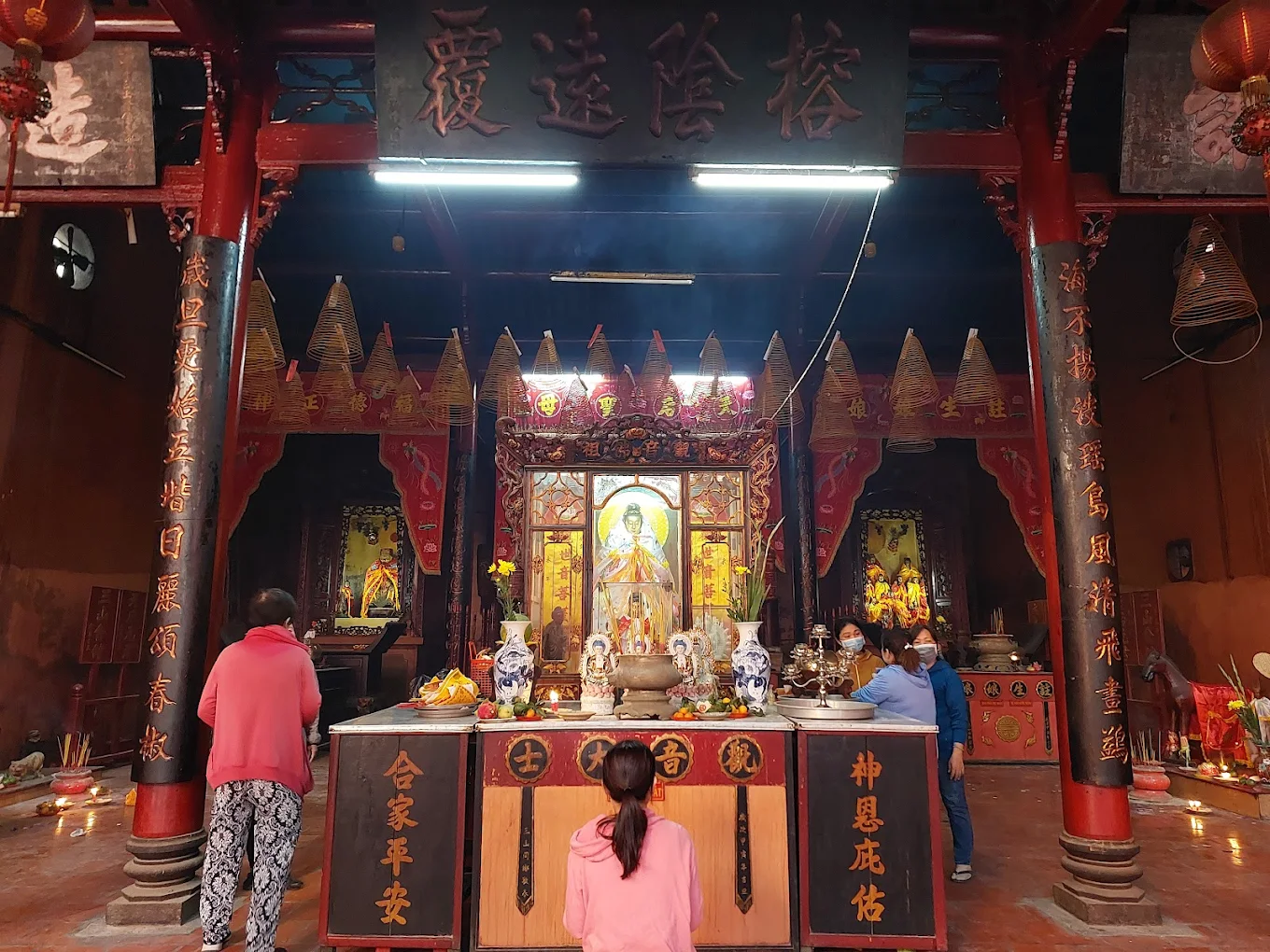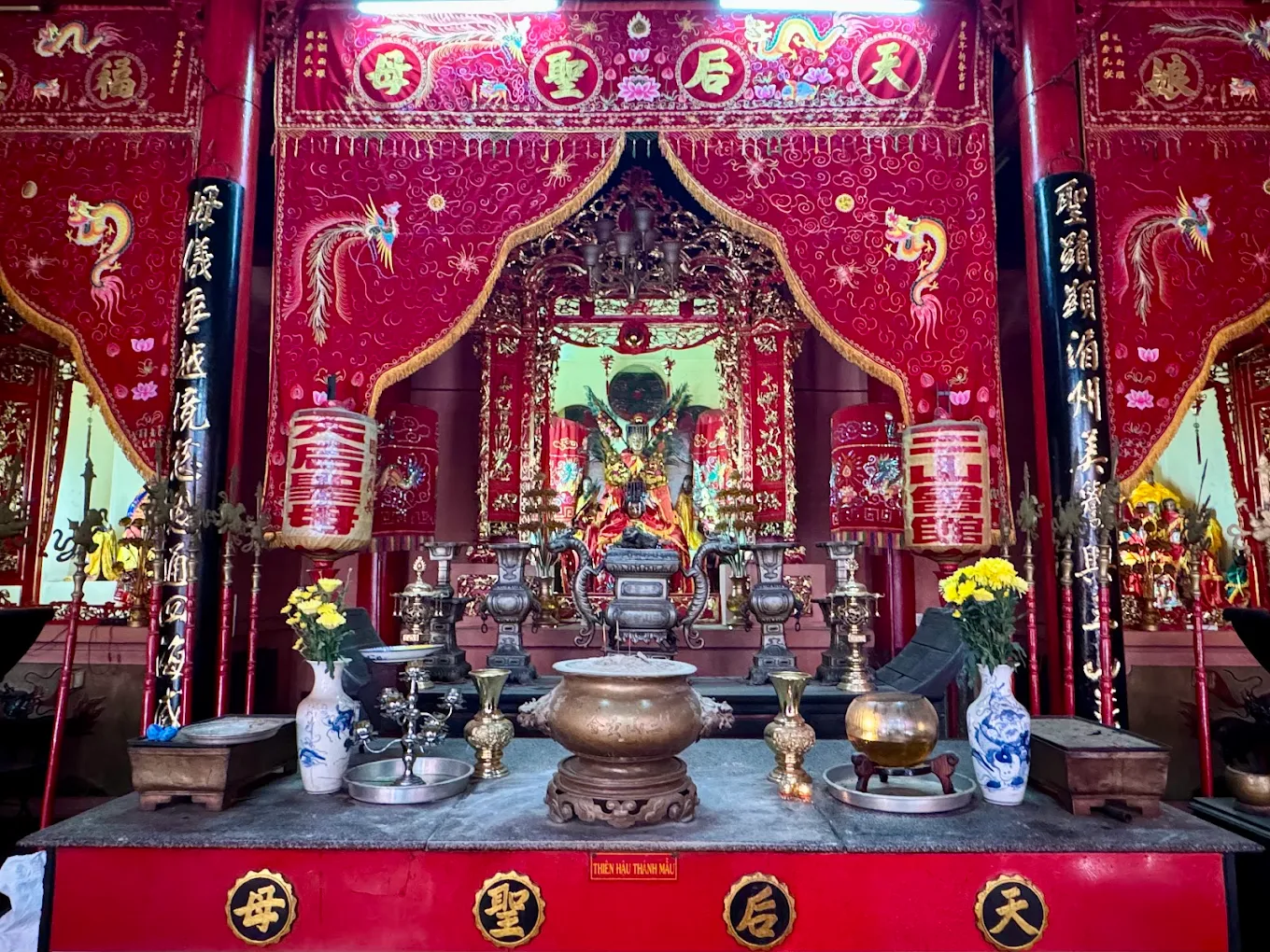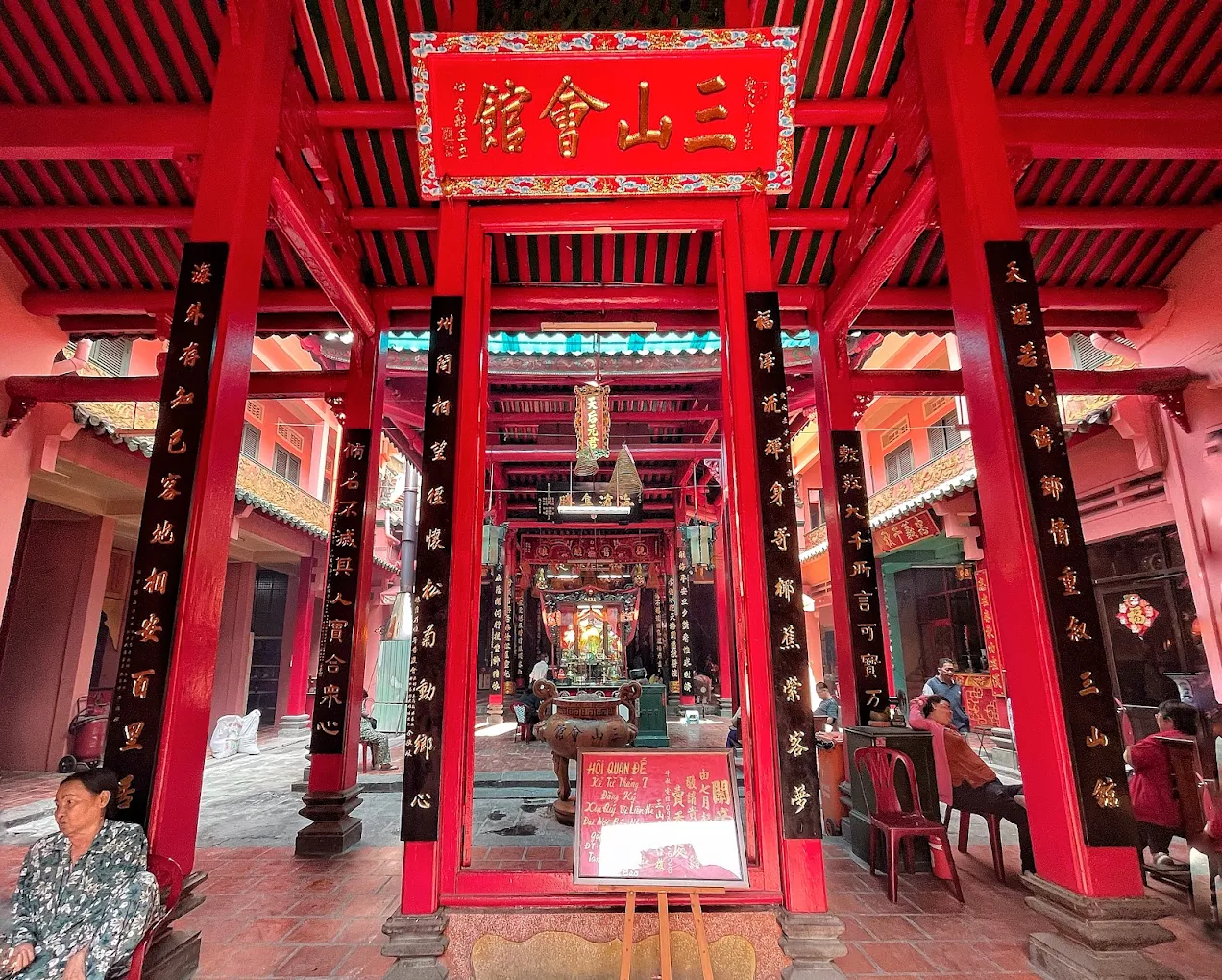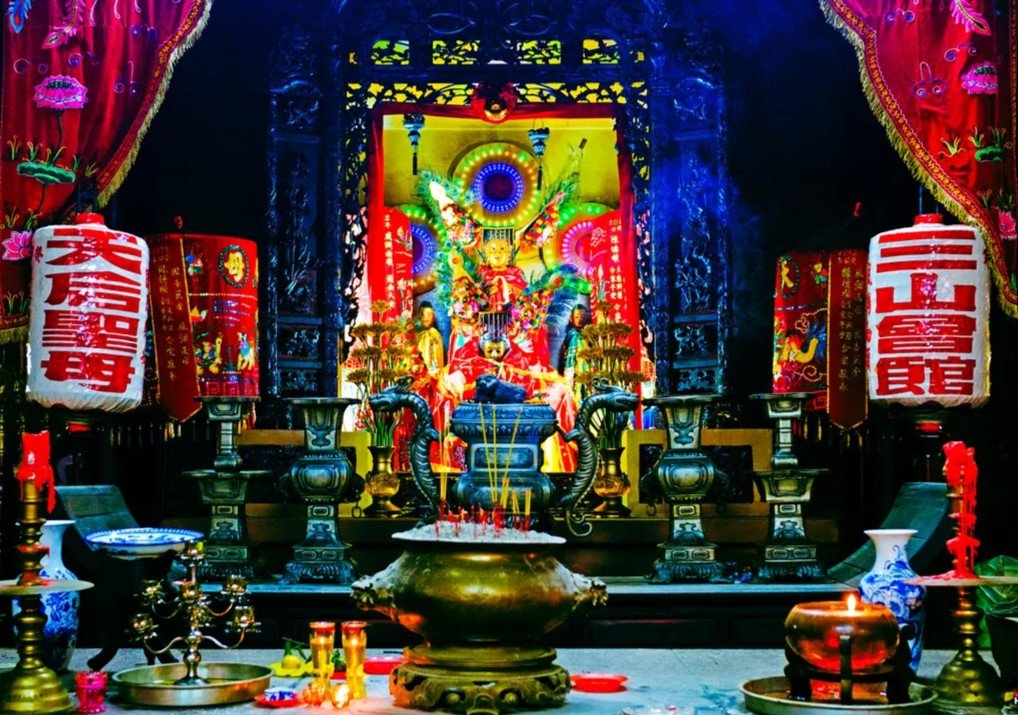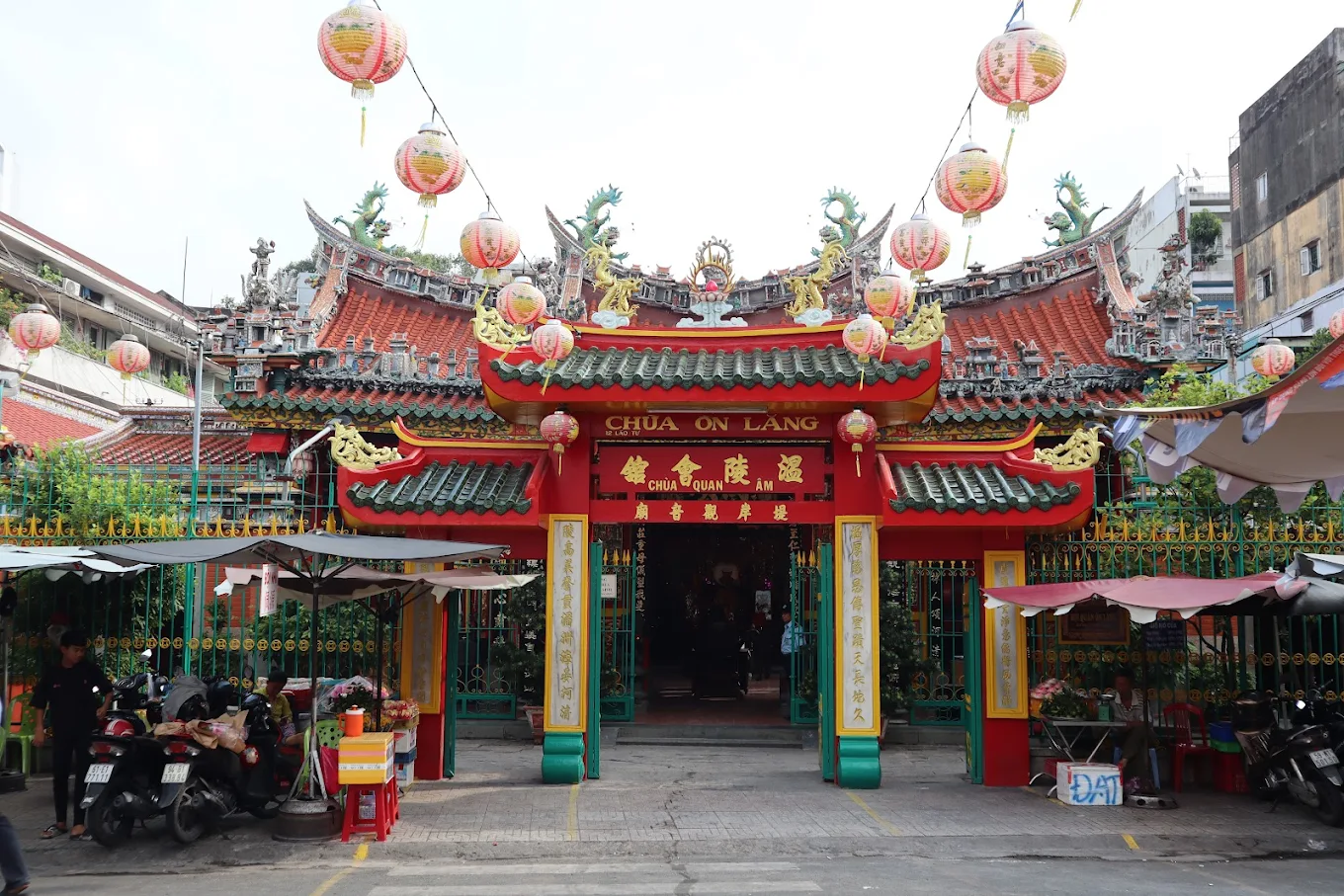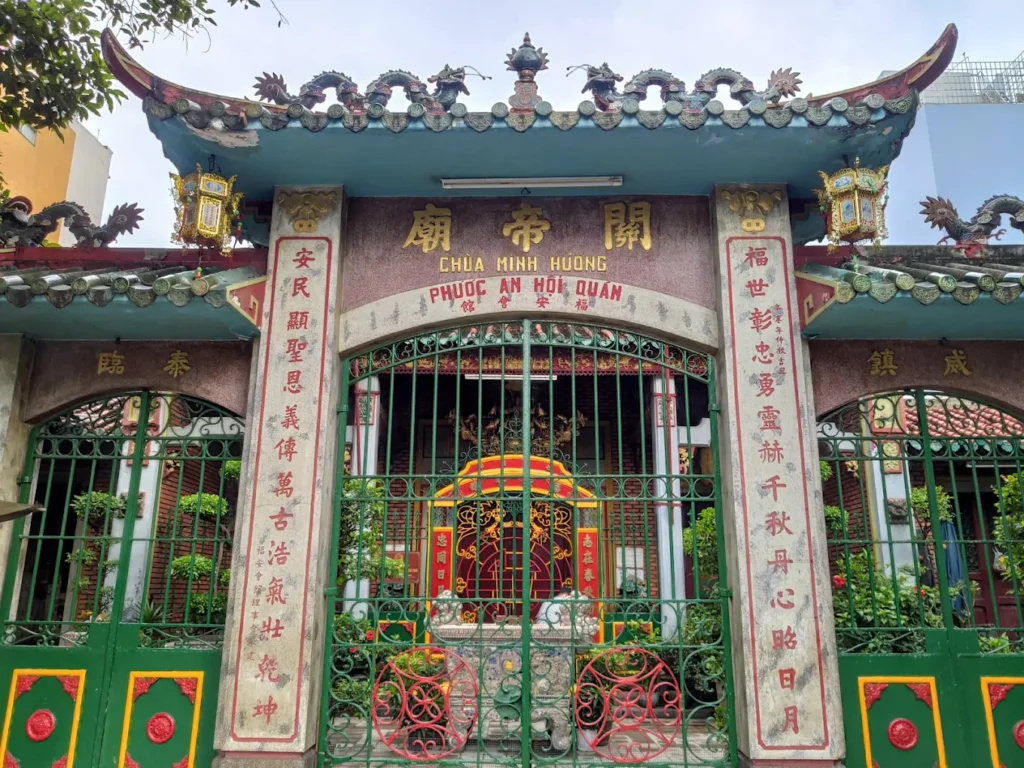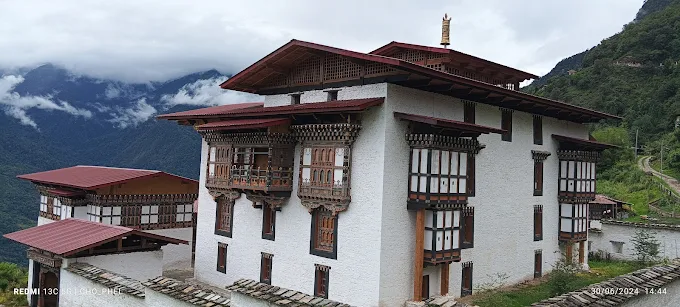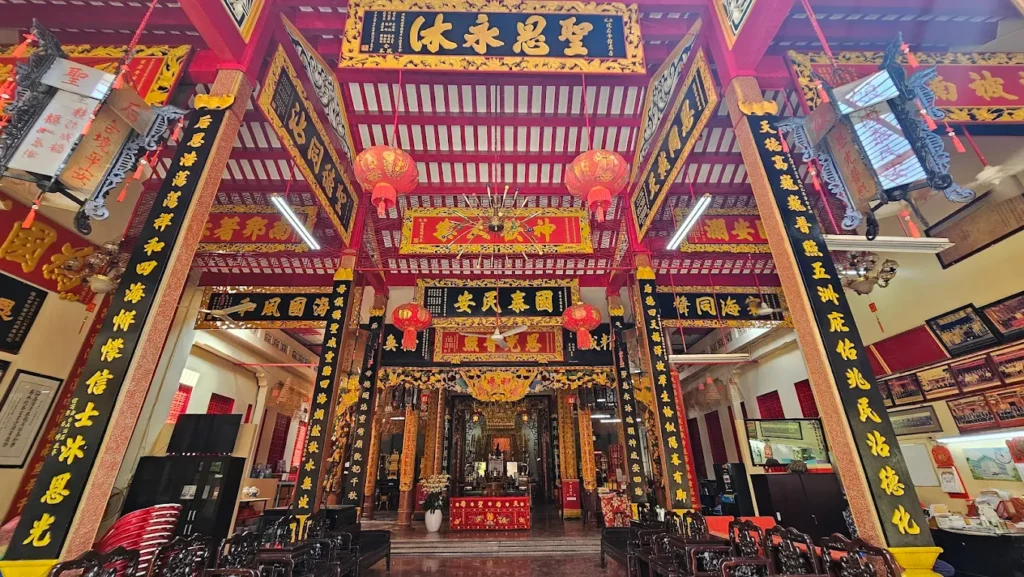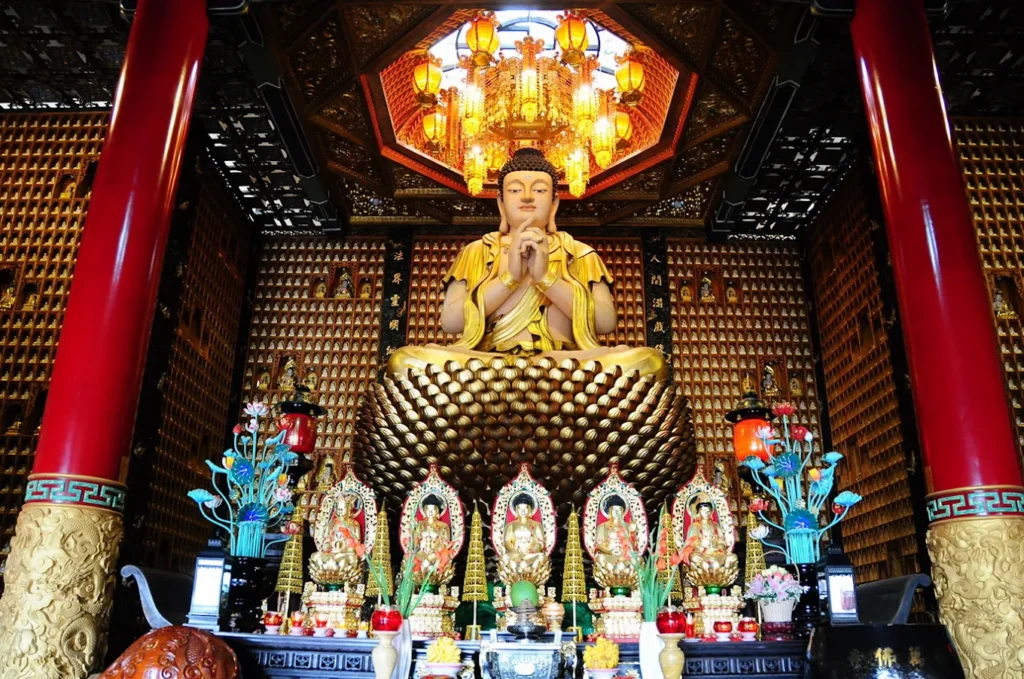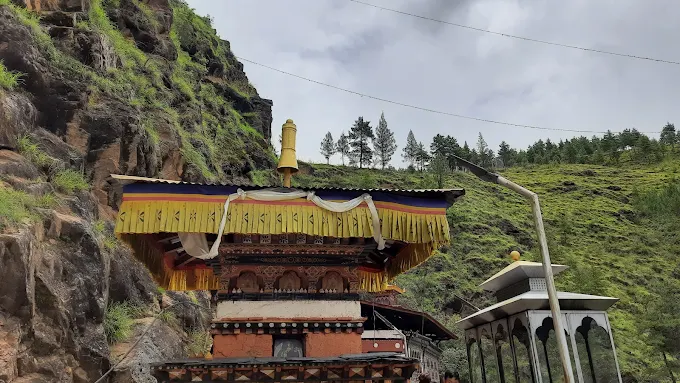Tam Sơn Hội Quán Pagoda: The Sacred Haven of Fujianese Fertility Worship
In the heart of Chợ Lớn, sandalwood incense swirls, guiding you to Tam Sơn Hội Quán Pagoda. Its red facade glows under Ho Chi Minh City’s sun, framing a sanctuary where Mẹ Sanh [Goddess of Fertility] offers hope to couples with lotus-laden prayers. Built in 1839 by Fujianese immigrants from Fuzhou, this Taoist temple resonates with chants and the soft chime of bells, echoing centuries of devotion. Dragon carvings coil across wooden beams, their scales etched with artisanal precision. Amid District 5’s vibrant streets, Tam Sơn’s courtyards provide a serene refuge, inviting you to explore its sacred heritage and Fujianese artistry.
Overview and Significance of Tam Sơn Hội Quán Pagoda
Tam Sơn Hội Quán Pagoda stands as a spiritual cornerstone of Ho Chi Minh City’s Fujianese community, weaving Taoist devotion with cultural heritage. Founded in 1839 by Fuzhou immigrants, it honors the “Three Mountains” (Bình Sơn, Cửu Tiên Sơn, Việt Vương Sơn), tying the temple to its ancestral roots. Mẹ Sanh, the Goddess of Fertility, draws pilgrims seeking blessings for children, while Thiên Hậu [Goddess of the Sea] protects seafarers. Its red-and-gold halls, adorned with Fujianese craftsmanship, host vibrant festivals and charity, cementing its role in Chợ Lớn’s multicultural fabric. This exploration delves into Tam Sơn Hội Quán Pagoda’s history, cultural weight, and enduring legacy.
Introduction to Tam Sơn Hội Quán Pagoda
Nestled in District 5, Tam Sơn Hội Quán Pagoda embodies Fujianese identity. Its name, “Tam Sơn,” reflects Fuzhou’s sacred peaks, symbolizing homeland pride. Mẹ Sanh [Goddess of Fertility], also called Kim Huệ Thánh Mẫu, is a beacon for childless couples, her altar aglow with offerings. Her nurturing presence, rooted in Taoist compassion, offers hope through prayers and lotus flowers. Thiên Hậu and Guan Yu [Quan Công], a deified warrior, complement its pantheon, blending Taoist and Buddhist reverence in Chợ Lớn’s dynamic landscape.
Historical Journey
Tam Sơn emerged in 1839 as a guildhall for Fujianese immigrants in Chợ Lớn. A 1954 stele suggests earlier origins in 1796 (Gia Khánh era), but temple records confirm 1839 as the founding year. Restorations in 1887 and 1954 preserved its structure through wars and urban growth. Key milestones include:
- 1839: Founded by Fuzhou settlers.
- 1887: Front hall renovated, adding dragon reliefs.
- 1954: Stele documented repairs, ensuring continuity.
Cultural Significance
Tam Sơn anchors Chợ Lớn’s cultural tapestry, uniting Fujianese descendants and locals. Annual festivals, like the Lantern Festival [Tết Nguyên Tiêu], feature lion dances and communal feasts, fostering unity. The Hungry Ghost Festival [Cúng Cô Hồn] sees offerings for wandering spirits, reflecting Taoist charity. Mẹ Sanh’s fertility rituals draw diverse worshippers, while the pagoda’s support for schools and aid amplifies Tam Sơn Hội Quán Pagoda’s cultural resonance.
Unique Legacy
Tam Sơn’s legacy lies in its fertility worship and Fujianese artistry. Mẹ Sanh’s gold-leaf altar, paired with Thiên Hậu’s maritime shrine, defines its spiritual core. Carved wooden panels and lacquered boards, inscribed with Fuzhou calligraphy, set it apart from Teochew or Cantonese temples, showcasing a distinct aesthetic in District 5.
Community and Global Impact
Tam Sơn connects Fujianese communities across Vietnam, Malaysia, and Singapore, hosting cultural exchanges. Locally, it organizes weddings, festivals, and literacy classes, strengthening District 5’s social bonds. Globally, pilgrims visit to honor ancestral traditions, with Fujianese diaspora in Southeast Asia drawing inspiration from its rituals, enhancing Tam Sơn Hội Quán Pagoda’s global reach.
Historical Anecdotes
Community elders recount a childless couple conceiving twins after praying to Mẹ Sanh, spreading the pagoda’s fame. Another tale describes a Fuzhou artisan, Chen Wei, carving the dragon reliefs in 1887, embedding Taoist blessings in each stroke. These verified stories enrich Tam Sơn’s lore, tying devotion to artistry.
Social Role
Tam Sơn serves as a community hub, hosting workshops and charity drives. During the Hungry Ghost Festival, it distributes food to the needy, embodying Taoist compassion. Its open doors welcome all, fostering inclusivity in Chợ Lớn’s diverse neighborhood, distinct from monastic-focused temples.
Artistic Influence
Tam Sơn’s dragon motifs and red-and-gold aesthetic inspire Chợ Lớn’s murals and local art. Its preserved woodwork, unlike Vietnamese pagodas’ stone-heavy designs, influences District 5’s visual culture. The pagoda’s artistry, from calligraphy to carvings, underscores Tam Sơn Hội Quán Pagoda’s enduring creative legacy.
Tam Sơn’s history, steeped in Fujianese devotion, shapes its physical and spiritual presence. The pagoda’s red halls and sacred altars, crafted with ancestral skill, invite exploration of its architectural and spiritual features, revealing Tam Sơn Hội Quán Pagoda’s artistry.
Architectural and Spiritual Features
Tam Sơn Hội Quán Pagoda’s architecture blends Fujianese Taoist design with spiritual symbolism, its red facade and green-tiled roofs standing vibrant in District 5. Spanning 1,000 square meters, its ascending layout—from courtyard to main shrine—guides worshippers toward reverence. Mẹ Sanh and Thiên Hậu’s altars, gilded and serene, anchor its sacred core, while Guan Yu’s statue adds martial reverence. Dragon carvings and nature murals reflect Fuzhou’s craftsmanship, distinct from Chợ Lớn’s other temples. This exploration unveils Tam Sơn Hội Quán Pagoda’s design, deities, and artisanal heritage.
Iconic Design
Tam Sơn’s design follows Fujianese principles, with a three-door gate [tam quan] opening to an airy courtyard. Its red exterior, symbolizing prosperity, contrasts with green-tiled roofs, evoking harmony. The ascending halls, unlike Vietnamese Quốc-shaped layouts, create a spiritual journey toward the main shrine.
Key Structures
The pagoda includes:
- Courtyard: Stone benches and incense burners create a serene entry.
- Front Hall: Lacquered boards bear Chinese calligraphy.
- Middle Hall: Houses Guan Yu’s altar.
- Main Shrine [chánh điện]: Elevated, dedicated to Mẹ Sanh and Thiên Hậu, the main hall radiates reverence with gold accents.
Worshipped Statues/Deities
Key deities include:
- Mẹ Sanh [Goddess of Fertility]: A 1.5-meter bronze statue, draped in gold-embroidered robes, symbolizes nurturing hope. Couples offer lotus flowers, seeking conception blessings in Fujianese Taoist tradition.
- Thiên Hậu [Goddess of the Sea]: A 1.2-meter wooden statue, crowned with pearls, protects seafarers. Her altar, adorned with maritime motifs, reflects Fuzhou’s coastal heritage.
- Quan Công [Guan Yu]: A 1-meter wooden statue, with a black beard and red horse, honors Guan Yu, a Three Kingdoms warrior deified for loyalty. Fujianese devotees revere him alongside Mẹ Sanh, blending Taoist and Buddhist reverence in Chợ Lớn’s syncretic culture.
Materials and Techniques
Artisans used jackfruit wood [gỗ mít] for carvings, valued for durability, and red lacquer for panels. Green-glazed roof tiles, imported from Fujian, withstand tropical rains. Stone pillars, etched with phoenixes, showcase Fuzhou’s masonry, distinct from Vietnamese stonework.
Signature Elements
The dragon relief above the entrance, carved in 1887, depicts Two Dragons Chasing the Pearl [Lưỡng Long Tranh Châu], symbolizing power. The “Tam Sơn Hội Quán” wooden sign, inscribed in Chinese, dates to 1839, a preserved relic unique to this pagoda.
Lesser-Known Features
Subtle details include:
- Lotus Murals: Wall paintings symbolizing purity.
- Calligraphic Boards: 19th-century Fuzhou inscriptions.
- Incense Coils: Ceiling-hung, burning for weeks, enhancing the sacred ambiance.
Preservation Efforts
Restorations in 1887 and 1954 reinforced the roof and pillars, using Fujianese techniques. Recent community-funded waterproofing preserves the tiles, ensuring Tam Sơn Hội Quán Pagoda’s structural integrity.
Environmental Integration
The courtyard’s feng shui [phong thủy] alignment channels positive energy, its open design cooling the halls. This harmony with Chợ Lớn’s urban setting contrasts with rural cave shrines, grounding Tam Sơn’s spiritual role.
Artisan Narratives
Fuzhou carver Chen Wei crafted the 1887 dragon reliefs, embedding Taoist symbols. His descendants maintain the pagoda, their stories verified by community records, enriching Tam Sơn Hội Quán Pagoda’s heritage.
Symbolic Details
Red hues signify luck, green tiles growth. Phoenix carvings on pillars symbolize renewal, resonating with Mẹ Sanh’s fertility blessings, distinct from martial symbols in other Chợ Lớn temples.
Landscape Integration
Stone pathways and potted plants in the courtyard foster meditation. Surrounded by District 5’s markets, Tam Sơn’s urban oasis contrasts with rural pagodas, amplifying its spiritual allure.
Tam Sơn’s architecture, from dragon reliefs to sacred altars, supports its vibrant rituals. These practices, centered on Mẹ Sanh and Thiên Hậu, bring the pagoda’s spiritual essence to life, inviting exploration of Tam Sơn Hội Quán Pagoda’s ceremonies.
Rituals and Practices
Tam Sơn Hội Quán Pagoda’s rituals embody Fujianese Taoist traditions, with Mẹ Sanh’s fertility blessings at their core. Daily incense offerings fill the air, while festivals like the Lantern Festival draw crowds with vibrant ceremonies. Verified by temple logs and elders, these practices reflect Tam Sơn’s role as Chợ Lớn’s spiritual heart. From unique fertility rites to communal celebrations, this exploration unveils Tam Sơn Hội Quán Pagoda’s sacred customs.
Daily Sacred Rites
Each dawn, devotees light incense at Mẹ Sanh’s altar, praying for children. Monks chant Taoist scriptures, their voices mingling with bell chimes. Evening candle offerings to Thiên Hậu honor seafarers, creating a serene rhythm in District 5.
Unique Practices
Couples offer lotus flowers and red envelopes to Mẹ Sanh, tying red ribbons on her altar to enhance conception—a Fujianese custom distinct from Buddhist rites. These verified rituals draw hopeful worshippers, unique to Tam Sơn Hội Quán Pagoda.
Festival Traditions
Key festivals include:
- Lantern Festival [Tết Nguyên Tiêu]: On the 15th day of the first lunar month, lion dances and lanterns light the courtyard.
- Hungry Ghost Festival [Cúng Cô Hồn]: On the 15th day of the seventh lunar month, roasted pig [heo quay] offerings honor spirits.
- Thiên Hậu’s Birthday: On the 23rd day of the third lunar month, processions feature seafood offerings.
Visitor Engagement
Visitors join daily prayers, lighting incense under monk guidance. During festivals, guests craft lanterns or offer food, immersing in Fujianese traditions, enriching their experience at Tam Sơn Hội Quán Pagoda.
Spiritual Community Roles
Monks lead rituals, while lay practitioners [cư sĩ], often women, maintain Mẹ Sanh’s altar, reflecting Fujianese matriarchal roles. These devotees, verified by community interviews, organize festivals, blending devotion with service.
Interfaith Connections
Tam Sơn blends Taoist and Buddhist elements, with Guan Yu’s altar attracting Vietnamese worshippers. This syncretism, unique to Chợ Lớn, broadens its spiritual appeal, distinct from purely Taoist temples.
Ritual Symbolism
Lotus flowers symbolize purity in fertility rites, red ribbons life. Thiên Hậu’s seafood offerings reflect maritime gratitude, rooted in Fujianese coastal culture, enhancing Tam Sơn Hội Quán Pagoda’s ritual depth.
Seasonal Variations
Spring festivals emphasize fertility, drawing couples to Mẹ Sanh’s altar. Autumn rites focus on ancestral worship during the Hungry Ghost Festival, adapting to seasonal spiritual needs, verified by temple records.
Monastic/Community Life
Monks meditate and maintain altars, living simply. Lay practitioners volunteer for charity, reinforcing Tam Sơn’s role as a community hub, distinct from monastic-centric pagodas in Ho Chi Minh City.
Tam Sơn’s rituals, from incense offerings to vibrant festivals, invite visitors to engage with its spiritual heart. Practical guidance for exploring these practices enhances the journey, as detailed in Tam Sơn Hội Quán Pagoda’s visitor information.
Visitor Information
Tam Sơn Hội Quán Pagoda offers a serene escape in District 5, easily accessible for cultural exploration. From navigating Chợ Lớn’s vibrant streets to respecting Taoist customs, this guide provides verified logistics, excluding pricing, to deepen your experience at Tam Sơn Hội Quán Pagoda.
Navigating to Tam Sơn Hội Quán Pagoda
From District 1’s Bến Thành Market, travel west on Lê Lợi Street, then south on Nguyễn Trãi toward Chợ Lớn. The pagoda sits near Triệu Quang Phục and Trần Hưng Đạo streets, its red facade and dragon reliefs marking the way amidst bustling markets.
Address of Tam Sơn Hội Quán Pagoda
The pagoda is located at 118 Triệu Quang Phục Street, Ward 11, District 5, Ho Chi Minh City, Vietnam.
Visiting Hours and Etiquette
Open daily from 6:00 AM to 10:00 PM, Tam Sơn welcomes visitors year-round. Wear modest clothing, covering shoulders and knees, and remove shoes in the main hall. Silence phones and speak softly to honor worshippers.
Transport Options
Reach Tam Sơn by:
- Motorbike: Common in District 5, with nearby parking.
- Taxi or Grab: A 15-minute ride from District 1.
- Bus: Route 5 from Bến Thành to Trần Hưng Đạo–Trần Phú, then a 5-minute walk.
- Walking: Feasible from nearby Bà Thiên Hậu Pagoda.
Accessibility and Safety
Flat pathways aid wheelchair access, though the main shrine has steps. Watch for motorbike traffic on Triệu Quang Phục Street. Stay hydrated in Ho Chi Minh City’s humidity and secure valuables in crowded areas.
Amenities and Surroundings
The courtyard offers restrooms and seating. Nearby tea stalls and phở shops provide refreshments. Chợ Lớn’s Bình Tây Market, a short walk away, adds vibrant post-visit exploration.
Immersive Visitor Tips
Visit at dawn for quiet prayers or during the Lantern Festival for lively rituals. Light incense at Mẹ Sanh’s altar, guided by monks, and study the dragon reliefs to appreciate Fujianese artistry.
Nearby Cultural Experiences
Explore:
- Bà Thiên Hậu Pagoda: A Cantonese temple, 10 minutes away.
- Bình Tây Market: Historic market for local goods.
- Nghĩa An Hội Quán: Fujianese pagoda with red horse statues.
Photography Tips
Photography is permitted, but avoid flash near altars. Capture dragon reliefs and incense coils from the courtyard. Respect worshippers by not photographing active prayers.
Tam Sơn’s rituals and architecture reveal its spiritual depth, but its philosophical and community insights deepen the experience, inviting reflection on Tam Sơn Hội Quán Pagoda’s significance.
Cultural and Spiritual Insights
Tam Sơn Hội Quán Pagoda’s Taoist roots and Fujianese identity shape its cultural and spiritual resonance. Its fertility worship and community resilience reflect Chợ Lớn’s multicultural spirit. Verified by temple records and elders, these insights illuminate Tam Sơn Hội Quán Pagoda’s philosophical and symbolic role.
Religious Philosophy
Taoism at Tam Sơn emphasizes harmony and compassion, with Mẹ Sanh embodying nurturing energy. Devotees seek balance through prayers, aligning with yin-yang principles, distinct from Buddhist detachment. This philosophy fosters hope, drawing couples to the pagoda’s altars.
Environmental Spirituality
The pagoda’s feng shui alignment channels positive energy, its courtyard fostering calm amid urban bustle. This Taoist reverence for nature, verified by temple design, contrasts with urban-focused shrines, grounding Tam Sơn’s spiritual ambiance.
Artistic Symbolism
Dragon carvings symbolize power, lotus murals purity. These Fujianese motifs, rooted in Fuzhou mythology, distinguish Tam Sơn from Vietnamese pagodas, enriching its artistic legacy with cultural depth.
Community Resilience
Fujianese donations for restorations showcase devotion. Festival charity, like food distribution during the Hungry Ghost Festival, embodies Taoist generosity, verified by community records, strengthening District 5’s bonds.
Environmental Stewardship
Sustainable practices, like rainwater collection in the courtyard, reflect Taoist respect for nature. These efforts, unlike urban temples’ concrete focus, preserve Tam Sơn’s serene environment, verified by temple logs.
Meditative/Contemplative Practices
Devotees meditate before Mẹ Sanh’s altar, seeking inner peace. Open to visitors, these Taoist mindfulness practices foster reflection, enhancing Tam Sơn Hội Quán Pagoda’s spiritual allure.
Cultural Narratives
Legends of Mẹ Sanh granting twins to a childless couple, shared by elders, enrich Chợ Lớn’s oral tradition. These verified stories tie Tam Sơn to Fujianese devotion, amplifying its cultural weight.
Historical Context
Tam Sơn reflects Chợ Lớn’s 19th-century Fujianese migration, blending Chinese and Vietnamese cultures. Its festivals connect to Ho Chi Minh City’s multicultural history, verified by academic journals, anchoring its regional significance.
Tam Sơn’s cultural insights, from Taoist harmony to Fujianese legends, underscore its unique appeal. This enduring legacy, woven with devotion and artistry, beckons exploration, as captured in why you must visit Tam Sơn Hội Quán Pagoda.
Why You Have to Visit
Tam Sơn Hội Quán Pagoda’s red halls and Mẹ Sanh’s golden altar embody Fujianese devotion, offering a window into Chợ Lớn’s cultural heart. Its fertility rituals, dragon carvings, and vibrant festivals tell a story of resilience and artistry, distinct from other District 5 temples. From the serene courtyard to the incense-filled main hall, Tam Sơn invites reflection on faith and heritage. Visit to witness a living legacy, where Taoist compassion and Fujianese craftsmanship converge, leaving an indelible mark on Ho Chi Minh City’s spiritual landscape.
